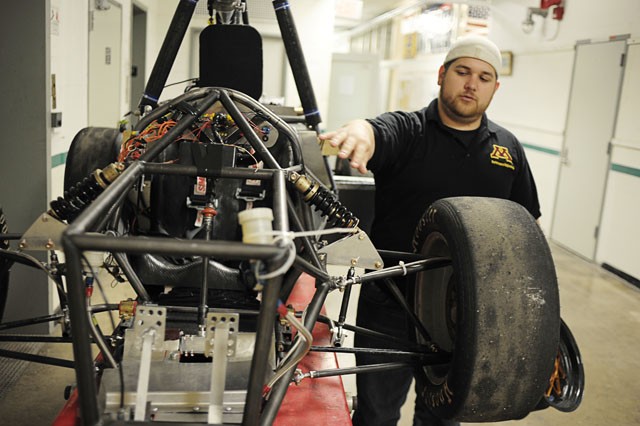Some people canâÄôt even pronounce the word chassis, let alone build one. But for the University of MinnesotaâÄôs Formula SAE team, the word âÄìâÄì pronounced CHA-see âÄî is as commonplace as butter is to a baker.
ThatâÄôs because Formula SAE (short for Society of Automotive Engineers), the 25-student team made up mostly of mechanical engineering majors, is completing the annual task of building a racecar from scratch.
The group takes part in the national Formula SAE competitions, which challenge undergraduate and graduate students to design and build a small car, then present their prototype and compete against other teams in May.
âÄúWeâÄôre definitely in crunch time right now,âÄù said current team President Thomas Kornblum, gesturing to a full-size blackboard filled with tasks to be completed. âÄúFor the past six weeks weâÄôve had people come in on the weekend and stay until three or four in the morning.âÄù
Teams are told to imagine they have been commissioned by a major firm to design, build, test and present a prototype for nonprofessional autocross racers. The cars are judged on engineering design, cost of production, acceleration, endurance, fuel economy and presentation. The University first organized a team in 1995.
âÄúUnlike a class where you can sometimes talk the professor into giving you an extension on a paper, their car must perform in Michigan,âÄù William Durfee, a faculty adviser for the team, said. âÄúThis is very real-world.âÄù
And the hands-on experience pays off. Last year, six of the eight graduating seniors found jobs at major engineering corporations like Honeywell, which sponsors the team each year.
âÄúTheyâÄôve employed team alumni in the past,âÄù Nicholas Richardson, a five-year member of the team, said. âÄúThey know the quality of engineering theyâÄôll get from us.âÄù
Members of the team have also found ways to gain academic credit for their work in SAE, Kornblum said. Several parts of the car, such as the wheel center, were senior projects, and several current members work on the vehicle as part of independent-study courses at the University.
The team spent the fall semester designing a 3-D layout of the racecar, following the guidelines provided by Formula SAE, which limit teams to a 610cc engine, a 20mm air restrictor. There are also several safety guidelines to protect the student drivers.
The cars are open cab, open wheel, single-seat racecars and typically weigh about 500 pounds.
The 2011 car weighs in at 465 pounds, significantly less than previous years. It averages speeds of 75 mph, though it can reach 135 mph in theory. If produced commercially, the car could be priced at more than $100,000, Kornblum said.
âÄúWe focused on taking everything we did right and wrong last year and smashing them together,âÄù Kornblum said. âÄúThis year weâÄôre aiming for a slot in the top 15.âÄù
Last year, the teamâÄôs car placed 82nd because of engine issues. In 2009, it placed 29th.
The car was first drivable in early April, and members of the team drove in the Honeywell parking lot on April 9.
âÄúThis car is insanely fast,âÄù Kornblum said. âÄúItâÄôs fun, and it will strain you on the corners. Keeping your head straight is difficult.âÄù
This semester, members of the team met every Wednesday to build the 2011 racecar out of materials donated by sponsors such as 3M, Toro, Caterpillar and Honda. Sponsors fund the UniversityâÄôs SAE team almost in full, supplying the team with building materials, manufacturing services and money to build the car and travel to Michigan.
Funds have been tight for the past three years, however, mainly due to the economy, Kornblum said.
âÄúWeâÄôre pretty far in debt right now,âÄù he said. âÄúFunds from sponsors have been smaller, so weâÄôre focusing on reaching out to alumni of the team or the department.âÄù
Kornblum said the team is currently working with the mechanical engineering department on a payment plan to reconcile its debt.
Competitions take place either in May at the Michigan International Speedway, or in June at the Auto Club Speedway in California. The competition in Michigan is the older of the two, first taking place in 1979 and with a limit of 120 teams versus CaliforniaâÄôs limit of 80.
The 2011 prototype will be displayed for the public April 25 at the Shakopee headquarters of Toro.
Engineering students’ car runs races, starts careers
The University’s Formula SAE team starts racing in May.

Image by Mark Vancleave
Formula SAE president Thomas Kornblum explains the new suspension on their car Wednesday in the Mechanical Engineering Building.
by Megan Nicolai
Published April 21, 2011
0

